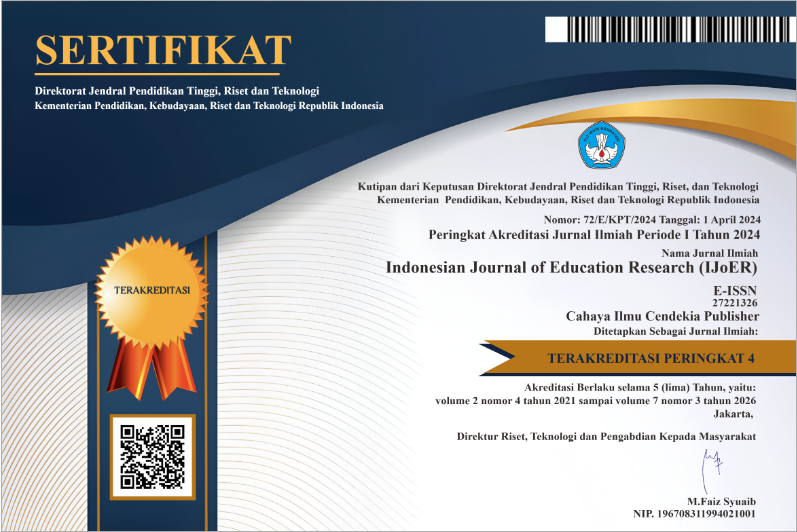The Effect Of Using English Cartoon Movie On The Seventh Grade Students’ Vocabulary Mastery
Abstract
Purpose of the study: The research aimed to investigate the effect of using English cartoon movie on the seventh grade students’ vocabulary mastery at SMP Negeri 01 Kabupaten Tebo.
Methodology: This design of research was quasi-experimental research design which involved two classes, grouped into experimental class (n=24) and control class (n=24). To know the effect of using English cartoon movie on students’ vocabulary mastery, there were three steps in collecting the data; they were pretest, treatment and post-test.
Main Findings: The result of post-test in experimental class showed that the mean score was 86.88. Meanwhile, the mean score in control class was 77.08. The difference of mean score of both classes was 9.8. From those results, the researcher found that the class taught with using English cartoon movie performed better than the class taught without using English cartoon movie. Furthermore, the analysis of t-test result showed t-test Sig. 2-tailed (.000) was lower than t-table (.05) (.000 < .05). So, the result of this study was there was a significant effect of using English cartoon movie on the seventh grade students’ vocabulary mastery at SMP Negeri 01 Kabupaten Tebo.
Novelty/Originality of this study: The teacher have already served them with the meaning of the vocabulary, they were likely to bring dictionary and memorize it. There were no new innovation happened in this class, so the students did not any attention to the vocabulary that been learned.
References
[2] M. D. W. Ernawati, A. Asrial, R. Perdana, S. E. Septi, S. Rohana, and A. M. Nawahdani, “Evaluation of Students’ Interest, Attitudes, and Science Process Skills in Science Subjects,” J. Educ. Res. Eval., vol. 6, no. 1, pp. 181–194, 2022, doi: 10.23887/jere.v6i1.37583.
[3] C. S. Chai and S.-C. Kong, “Professional learning for 21st century education,” J. Comput. Educ., vol. 4, no. 1, pp. 1–4, 2017, doi: 10.1007/s40692-016-0069-y.
[4] İ. Y. Kazu and A. İş, “An Investigation About Actualization Levels of Learning Outcomes in Early Childhood Curriculum,” J. Educ. Train. Stud., vol. 6, no. 3, p. 66, 2018, doi: 10.11114/jets.v6i3.2928.
[5] R. S. Budiarti, D. A. Kurniawan, and S. Rohana, “A Comparison by Gender: Interest and Science Process Skills,” J. Educ. Res. Eval., vol. 6, no. 1, pp. 88–97, 2022, doi: 10.23887/jere.v6i1.37723.
[6] T. R. Tretter, Y. Ardasheva, J. A. Morrison, and A. Karin Roo, “Strengthening science attitudes for newcomer middle school english learners: visually enriched integrated science and language instruction,” Int. J. Sci. Educ., vol. 41, no. 8, pp. 1015–1037, 2019, doi: 10.1080/09500693.2019.1585993.
[7] U. H. Mohd Hasri, M. A. Md Syed, and C. Runnel, “Transmedia storytelling in the Malaysian animation industry: embedding local culture into commercially developed products,” Atl. J. Commun., vol. 00, no. 00, pp. 1–17, 2020, doi: 10.1080/15456870.2020.1835909.
[8] K. Kamid, R. Rohati, H. Hobri, E. Triani, S. Rohana, and W. A. Pratama, “Process Skill and Student ’ s Interest for Mathematics Learning : Playing a Traditional Games,” Int. J. Instr., vol. 15, no. 3, pp. 967–988, 2022.
[9] D. Rachmawati and C. H. Asmara, “Reading and Writing: Development of Project-Based Learning (PBL) Approach,” vol. 145, no. Iconelt 2017, pp. 48–53, 2018, doi: 10.2991/iconelt-17.2018.11.
[10] M. E. Gil Clemente and J. I. Cogolludo-Agustín, “The Effectiveness of Teaching Geometry to Enhance Mathematical Understanding in Children with Down Syndrome,” Int. J. Disabil. Dev. Educ., vol. 66, no. 2, pp. 186–205, 2019, doi: 10.1080/1034912X.2019.1571171.
[11] K. Kamid, S. Syaiful, R. Theis, S. Sufri, and S. Rohana, “Cooperative Learning Model with Process Skills for Mathematics Learning in Elementary School,” Int. J. Elem. Educ., vol. 6, no. 1, pp. 58–68, 2022.
[12] S. Rohana, Maison, D. A. Kurniawan, and E. Syari, “Analisis Model Discovery Learning Terhadap Karakter Disiplin Dan Keterampilan Proses Sains Siswa Pada Mata Pelajaran Fisika,” vol. 7, no. November, pp. 305–312, 2021.
[13] J. W. Creswell, Educational Research. Lincoln: University of Nebraska, 2012.
[14] J. W. Creswell, “Penelitian Kualitatif & Desain Riset,” Mycol. Res., vol. 94, no. 4, p. 522, 2015
[15] Arikunto, S. (2006). Prosedur penelitian suatu penelitian praktik (6th ed). Jakarta: Rineka Cipta.
[16] English, Tutor Vista, (2017), Retrieved 28, March, 2017, from http://english.tutorvista.com/vocabulary.htm
[17] Karim, M. & Hasbullah, F. A. (2008). Language teaching media. Jakarta: Universitas Terbuka.
[18] William, Y. (2013). Test-retest reliability coefficient: examples, lesson % quiz. Retrieved September, 24, 2017, from http://educationportal.com/academy/lesson/test-retest-reliabilitycoefficient-examples-lesson
[19] Naution, P. (2002). Managing vocabulary learning RELC portfolio series 2. Singapore: SEAMO Regional Language Centre.
[20] Karim, M. & Hasbullah, F. A. (2008). Language teaching media. Jakarta: Universitas Terbuka.
Copyright (c) 2020 Zulty Anika Putri

This work is licensed under a Creative Commons Attribution-NonCommercial 4.0 International License.
Authors who publish with this journal agree to the following terms:
- Authors retain copyright and acknowledge that the Indonesian Journal of Education Research (IJoER) is the first publisher licensed under a Creative Commons Attribution 4.0 International License.
- Authors are able to enter into separate, additional contractual arrangements for the non-exclusive distribution of the journal's published version of the work (e.g., post it to an institutional repository or publish it in a book), with an acknowledgment of its initial publication in this journal.
- Authors are permitted and encouraged to post their work online (e.g., in institutional repositories or on their website) prior to and during the submission process, as it can lead to productive exchanges and earlier and greater citation of published work.






.png)
.png)




















